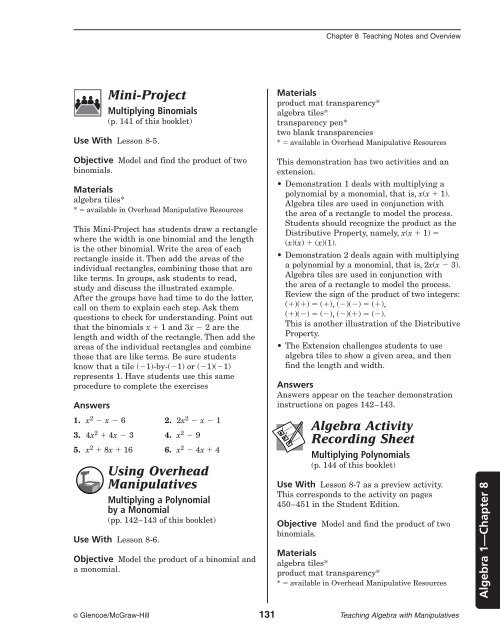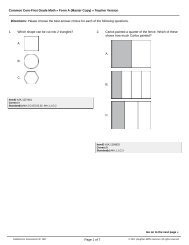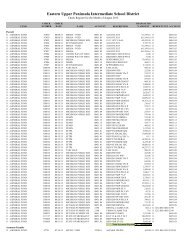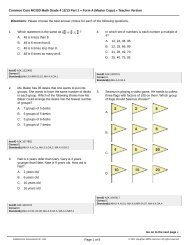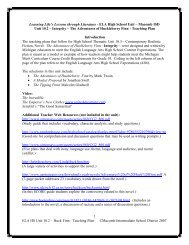Teaching Algebra with Manipulatives
Teaching Algebra with Manipulatives
Teaching Algebra with Manipulatives
You also want an ePaper? Increase the reach of your titles
YUMPU automatically turns print PDFs into web optimized ePapers that Google loves.
Chapter 8 <strong>Teaching</strong> Notes and Overview<br />
Mini-Project<br />
Multiplying Binomials<br />
(p. 141 of this booklet)<br />
Use With Lesson 8-5.<br />
Materials<br />
product mat transparency*<br />
algebra tiles*<br />
transparency pen*<br />
two blank transparencies<br />
* available in Overhead Manipulative Resources<br />
Objective Model and find the product of two<br />
binomials.<br />
Materials<br />
algebra tiles*<br />
* available in Overhead Manipulative Resources<br />
This Mini-Project has students draw a rectangle<br />
where the width is one binomial and the length<br />
is the other binomial. Write the area of each<br />
rectangle inside it. Then add the areas of the<br />
individual rectangles, combining those that are<br />
like terms. In groups, ask students to read,<br />
study and discuss the illustrated example.<br />
After the groups have had time to do the latter,<br />
call on them to explain each step. Ask them<br />
questions to check for understanding. Point out<br />
that the binomials x 1 and 3x 2 are the<br />
length and width of the rectangle. Then add the<br />
areas of the individual rectangles and combine<br />
those that are like terms. Be sure students<br />
know that a tile (1)-by-(1) or (1)(1)<br />
represents 1. Have students use this same<br />
procedure to complete the exercises<br />
Answers<br />
1. x 2 x 6 2. 2x 2 x 1<br />
3. 4x 2 4x 3 4. x 2 9<br />
5. x 2 8x 16 6. x 2 4x 4<br />
Using Overhead<br />
<strong>Manipulatives</strong><br />
Multiplying a Polynomial<br />
by a Monomial<br />
(pp. 142–143 of this booklet)<br />
Use With Lesson 8-6.<br />
Objective Model the product of a binomial and<br />
a monomial.<br />
This demonstration has two activities and an<br />
extension.<br />
• Demonstration 1 deals <strong>with</strong> multiplying a<br />
polynomial by a monomial, that is, x(x 1).<br />
<strong>Algebra</strong> tiles are used in conjunction <strong>with</strong><br />
the area of a rectangle to model the process.<br />
Students should recognize the product as the<br />
Distributive Property, namely, x(x 1) <br />
(x)(x) (x)(1).<br />
• Demonstration 2 deals again <strong>with</strong> multiplying<br />
a polynomial by a monomial, that is, 2x(x 3).<br />
<strong>Algebra</strong> tiles are used in conjunction <strong>with</strong><br />
the area of a rectangle to model the process.<br />
Review the sign of the product of two integers:<br />
()() (), ()() (),<br />
()() (), ()() ().<br />
This is another illustration of the Distributive<br />
Property.<br />
• The Extension challenges students to use<br />
algebra tiles to show a given area, and then<br />
find the length and width.<br />
Answers<br />
Answers appear on the teacher demonstration<br />
instructions on pages 142–143.<br />
<strong>Algebra</strong> Activity<br />
Recording Sheet<br />
Multiplying Polynomials<br />
(p. 144 of this booklet)<br />
Use With Lesson 8-7 as a preview activity.<br />
This corresponds to the activity on pages<br />
450–451 in the Student Edition.<br />
Objective Model and find the product of two<br />
binomials.<br />
Materials<br />
algebra tiles*<br />
product mat transparency*<br />
* available in Overhead Manipulative Resources<br />
<strong>Algebra</strong> 1—Chapter 8<br />
© Glencoe/McGraw-Hill 131 <strong>Teaching</strong> <strong>Algebra</strong> <strong>with</strong> <strong>Manipulatives</strong>


